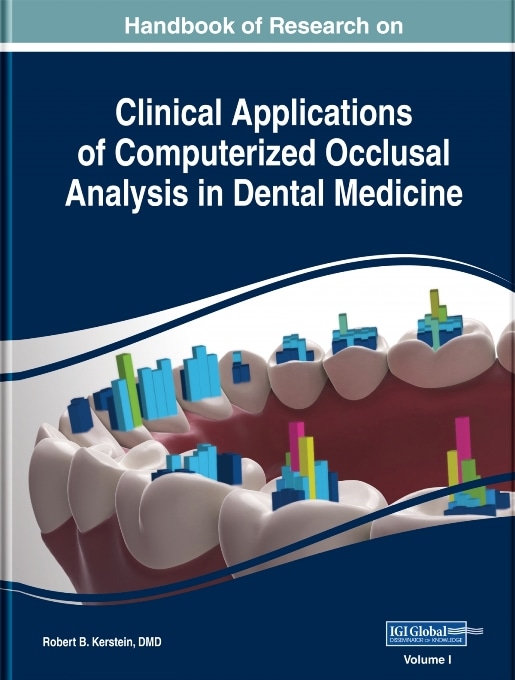The Handbook of Research on Clinical Applications of Computerized Occlusal Analysis in Dental Medicine (3 volumes), edited by Dr. Robert B. Kerstein, DMD, with contributions from 20 industry-leading research and dentistry experts from around the world, is undeniable evidence that measuring occlusion with the T-Scan digital occlusal analysis system is becoming the standard of care for dental practitioners worldwide.
 This three-volume handbook provides further validation with real-world cases covering the importance of using digital occlusal technology as part of a dentist's everyday treatment toolkit.
This three-volume handbook provides further validation with real-world cases covering the importance of using digital occlusal technology as part of a dentist's everyday treatment toolkit.
Dr. Kerstein is a global expert on the use and application of the T-Scan™ digital occlusal analysis system, and a pioneer and academic science advocate for digital occlusal technology. T-Scan, an instrument developed by Tekscan, Inc., is dentistry’s only digital occlusal analysis system that reveals the timing of force on the individual teeth and the occlusal stability of the overall bite. With the help of T-Scan, Dr. Kerstein teaches a measured system that greatly improves the success of bite-related procedures commonplace in every clinical practice.
The Handbook builds upon the 2015 best-selling publication, Handbook of Research on Computerized Occlusal Analysis Technology Applications in Dental Medicine (2 Volumes), edited by Dr. Kerstein, with fully enhanced chapters and new research findings that illustrate the scope and breadth of the field of computerized occlusal analysis and modern dental medicine.
The Handbook is an educational overview covering the many research-supported clinical applications that T-Scan technology offers to the daily dental practice. With T-Scan, dentists can better preserve their installed bridgework and implant restorations, better protect their brittle ceramic esthetic dentistry, and most importantly, improve the quality of their patient’s lives with improved bite comfort and chewing function.
Dr. Robert B. Kerstein, DMD
The Handbook features 19 chapters containing over 800+ full-color figures and a comprehensive list of references making it an ideal resource for dental healthcare providers, educators, researchers, students, and dental healthcare professionals. Innovative findings and research on applications for occlusal analysis technologies such as, dental arch digitalization, temporomandibular disorders, hypersensitive dentition, temporomandibular joint vibration analysis, orthodontic monitoring, orthodontics, periodontal treatment, and implant and conventional prosthodontics are contained within.
Any classroom teaching digital dentistry, whether at the university level, or a continuing education course, will benefit from teaching the innumerable impacts of digital occlusal technology across the entire digital workflow. Even though digital dentistry is still a new and growing concept, this Handbook shares decades’ worth of validation that is vital to dentistry’s future.
Dr. Robert B. Kerstein, DMD
Full list of contributors:
- Sarah Qadeer, BDS, MSD, Basel, Switzerland
- Dr. Lertrit Sarinnaphakorn, Faculty of Dentistry, Chulalongkorn University, Bangkok, Thailand
- Dr. Bernd Koos, University Medical Center Schleswig-Holstein, Germany
- Robert Anselmi, McGill University, Canada
- John Radke, BM, MBA. Bioresearch Associates, USA
- Curtis Westersund, DDS, Calgary, Canada
- Ray Becker, DDS, Ellicott City, Maryland, USA
- Nick Yiannios, DDS, Rogers, Arkansas, USA
- Tom Coleman, DMD, Brandon, Vermont, USA
- Dr. Teresa Sierpińska, MD, PhD, Bialystok, Poland
- Mark Piper, DMD, MD, Piper Educational and Research Center, St. Petersburg, Florida, USA
- Jinhwan Kim, DDS, MS, PhD, Seoul, South Korea
- Dr. Henriette Lerner, HL Dentclinic and Academy, Baden-Baden, Germany
- Julia Cohen-Levy, DDS, University of Montréal, Quebec, Canada
- Nicolas Cohen, DDS, Montréal, Canada
- Patrick Girouard, DDS, Moncton, Canada
- Ben A. Sutter DMD, Eugene, Oregon, USA
- John Droter, DDS, The Pankey Institute and Spear Education, USA
- Paul Mitsch, DMD, Augusta, Kansas, USA